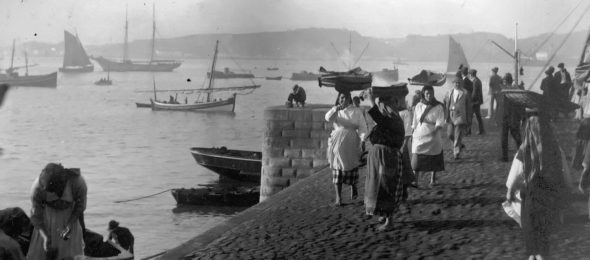Ports have played an important role in history as spaces of transit and transitions, of encounters and exchanges, of comings and goings. As nodes in trading networks and hubs of economic activity, ports serve as dynamic meeting spaces for peoples and cultures throughout time. Ports were also zones of conflict, spaces where wars and battles were fought, and where interests and convictions clashed. For some, ports signified freedom and possibilities; for others – such as enslaved people – captivity and extraction.
Despite its dynamic and multifaceted character, the port is often presented as a masculine place where men worked, sought entertainment and traveled from and to. In the 43rd edition of the Yearbook of Women’s History, with guest editor Irene Jacobs (Maritiem Museum Rotterdam), we want to question this stereotypical image by focusing on women who worked and lived in the port, who arrived or sailed from there, and the gendered constructions that shaped this environment. The volume wants to emphasize that women were and are active participants in all sections of the maritime industry on shore. From the repairing of nets, the selling of fish, making navigational instruments, housing sailors or keeping inns, to the maintaining of communities while the men were away at sea: women were key players in maritime societies. This new volume aims to travel to many ports around the world to investigate the role women have played in ports from economic, political, social, and cultural perspectives. In doing so, the volume will help scholars gain the broadest possible insight into the actions and influences of women in the port areas and the influence of the port on women from ancient times to the present.
In doing so, the volume focuses on the following questions: How were ports considered as a gendered space? Which forms of cultural expression did ports produce, and which role did gender play in them? Why do we know so little about women working, living, and staying in ports? Which (new) sources or methodologies could change this? From a more socio-economic perspective, this volume also considers the jobs and positions women held and their contribution to the maritime sector. How were gender roles imposed or negotiated in port labour? Was there occupational segregation, and in which jobs do we see the largest distributions? Which labour was traditionally seen as female labour, and why? Which roles did women take up in the port environment?
In addition to women, this collection also aims to focus on the broader effect of gender and the role of femininity and masculinity in the port. In this way, this collection touches on various intersections of gender with other political, socioeconomic, and cultural phenomena in the port.
We welcome contributions that employ different scales of analysis from all over the world, written by (academic) researchers, teachers, museum professionals, and other cultural and heritage experts. We are looking for articles that vary in length (3000-6000 words) and are written in Dutch or English. We also want to encourage authors to send in more creative expressions of (academic) writing, such as essays, image essays, or poems. Abstracts (200-300 words) written in English or Dutch are to be submitted by June 1, 2024 to jaarboekvrouwengeschiedenis@gmail.com.
Possible topics include:
• Women who worked in maritime industries ashore
• The port as a gendered place
• Women and slavery in ports
• Women’s roles in ports
• Women’s agency in ports
• Transoceanic perspectives on women in ports
• Gender, women, and criminality in ports
• Female piracy and ports
• Stigma, maritime world, and ports
• Ports and (ideas and practices of) masculinity and femininity
Important dates
June 1, 2024: Deadline for abstracts.
June 15, 2024: Information concerning acceptance will be sent to the writers.
October 1, 2024: Submission deadline first drafts to be submitted to editorial/peer review.
June 1, 2025: Submission deadline for final versions








